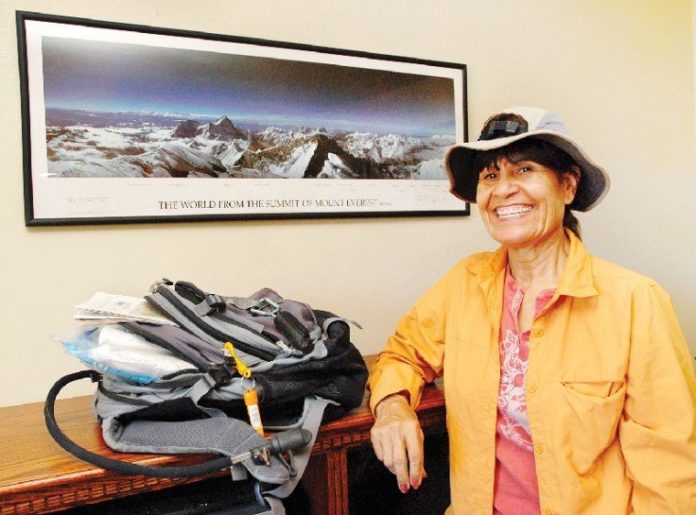A prized individuality is reflected in Lipa Harer’s fierce eyes,
not the only part of her face that speaks volumes. From the deeply
set smile lines one can guess a commitment to satisfaction while
her dark leathery skin and deep frown attest to an unwavering
will.
Gilroy – A prized individuality is reflected in Lipa Harer’s fierce eyes, not the only part of her face that speaks volumes. From the deeply set smile lines one can guess a commitment to satisfaction while her dark leathery skin and deep frown attest to an unwavering will.
At 69 years of age, the Gilroyan is going to need all those qualities when she attempts to conquer Mount Kilimanjaro this fall as part of a fund-raiser to build a 36-bed orphanage in Kenya for victims of AIDS.
Spanning eight days this October, the retired East Bay Regional Park District ranger will become one of oldest women ever to climb to the African summit of 19,340 feet, although it’s impossible to tell exactly where she stands because no formal record has been kept.
The rules change above 16,000 feet, a place where the body no longer “does” things so much as it “accomplishes” them. Be it standing on your own two feet or digesting food, the thinning supply of oxygen forces your heart to work harder. The headaches and headrushes come pounding almost systematically and every breath is a battle, a feeling hikers have likened to living with emphysema at sea level.
The feat is on Harer’s “things I need to do before I croak list” which also includes a trip to Earth’s southernmost point in Antarctica. It’s her second attempt to climb Kilimanjaro in 11 years and it has left her more determined than ever to pull through.
Gilroy lawyer Laura Perry was 47 years old when she climbed Kilimanjaro in 1998 and she remembers the conditions well.
“It’s dirty, it’s cold, it’s windy,” Perry said. “You lose your appetite so you lose your energy quickly. It’s very hard when you cannot breathe.”
On the outside, it’s Harer’s hands that betray her age – the skin on the back of them ripened with age spots and rife with veins that extend to knobby fingers. These are the working hands of a park ranger who knows the feel of dirt and tree trunks.
The inside of Harer’s body, coupled with seven decades of active living have given doctors reasons to give her warning. They tell her she has developed plantar fasciitis, a painful inflammation of the feet often associated with repetitive stress. To deal with the calcium deposits in her knees she wears braces on local hikes, but Kilimanjaro is another story.
Part of the challenge is that Kilimanjaro, Africa’s highest peak, is actually a volcano with a surface covered with scree – jagged sedimentary rock that makes for unstable footing. With that in mind, she is considering accepting a cortisone shot to her knees that her doctor has been offering as a way to leave the pain behind.
She joins 10 others for the first “Climb for a Cause,” to raise funds for a $130,000 orphanage for Kenyan children. Donations will also go to fund a medical clinic, HIV/AIDS testing and treatment, clean water projects, a sewing co-op and to rebuild a primary school, according to the charity.
Harer said she underestimated the difficulty of the climb during a 1996 recreational trip and had to turn around just above 16,000 feet. In the end, a bladder infection did her in but she was still the last of her group to give up.
Now 11 years after her first attempt, Harer said she is confident that a new training program gives her the legs to reach the top and the cause gives her an extra incentive – and a crucial mental edge.
“I’m totally convinced that if you are not prepared mentally it doesn’t matter how trained you are, you’re not going to make it,” Harer said.
This time around, everything has taken a backseat to training. She puts in cardiovascular and leg work on a stationary bike five days a week at the Gilroy Health & Fitness club, trains her upper body with weights and takes on 15-mile hikes at Henry Coe State Park several times a week to put it all to test.
Perry estimated the success rate for amateur climbers making it to the summit is an even 50 percent but she likes Harer’s odds.
“That she turned around (the last time) shows me she can make a good decisions,” said Perry, adding that women and elderly people in general are more likely to listen to their bodies. “It’s the same thing as any endurance sport. It’s 90 percent mental.”
Harer’s big plans for her 70th birthday next year? A one-day climb of Mount Whitney’s 14,495-foot peak during which she is sure to leave some friends struggling to keep up with her.














